We’ve all been there – staring at that awkward space that needs to pull double duty as both a cozy living area and peaceful bedroom. Whether you’re dealing with a studio apartment or simply want to maximize your home’s functionality, creating a room that seamlessly transitions between day and night living isn’t just possible – it’s brilliant.
The key lies in smart design choices that make your space work harder without sacrificing style or comfort. We’re talking about clever furniture arrangements, strategic storage answers, and visual tricks that’ll make your dual-purpose room feel intentional rather than cramped.
Transform your space into a sophisticated haven that guests will never guess serves multiple functions. With the right approach, you’ll create a room that feels spacious during the day and intimate at night, proving that small spaces can deliver big style.
Maximize Space With Murphy Beds and Wall-Mounted Solutions
Wall-mounted answers and Murphy beds transform cramped living room bedrooms into functional spaces that work around the clock. These smart installations free up valuable floor area while maintaining the comfort and style you need for both relaxation and sleep.
Choose a Horizontal Murphy Bed for Wider Rooms
Horizontal Murphy beds work best in rooms with greater width than height. We recommend measuring your space carefully before selecting this configuration, as horizontal models typically require 8 to 9 feet of wall width for proper installation. These beds fold down to create a comfortable sleeping surface while maximizing floor space during daytime hours.
Consider integrated storage options when selecting your horizontal Murphy bed. Many models feature built-in shelving units, desks, or cabinets that serve dual purposes. We’ve found that beds with attached nightstands or bookshelf components eliminate the need for additional furniture pieces.
Choose mechanisms with soft-close technology for safer operation. Quality horizontal Murphy beds include spring-loaded or piston-assisted systems that prevent the bed from slamming down. We suggest testing the mechanism before purchasing to ensure smooth operation that won’t disturb your living space routine.
Install Floating Nightstands to Save Floor Space
Floating nightstands mount directly to the wall without requiring floor support. We position these pieces 24 to 27 inches above the floor level for optimal accessibility from bed height. This mounting strategy creates visual lightness while providing essential bedside storage for books, devices, and personal items.
Select nightstands with hidden compartments for maximum organization. Wall-mounted models often include drawers, cable management systems, or charging stations built into their design. We prefer units with USB ports and wireless charging pads that eliminate cord clutter around the sleeping area.
Install floating nightstands on both sides of the bed for balanced aesthetics. Symmetrical placement creates a polished look while doubling your storage capacity. We recommend choosing matching finishes that complement your Murphy bed hardware for a cohesive appearance.
Use Wall-Mounted Reading Lights Instead of Table Lamps
Wall-mounted reading lights eliminate the need for bulky table lamps on nightstands. We install these fixtures 18 to 24 inches above mattress level for optimal task lighting without glare. Adjustable swing-arm models allow you to direct light precisely where needed for reading or other bedside activities.
Choose LED reading lights with dimmer controls for versatile ambiance. Modern wall-mounted fixtures offer adjustable brightness levels that transition from bright task lighting to soft ambient glow. We recommend lights with warm color temperatures between 2700K and 3000K for comfortable evening use.
Consider hardwired installation for permanent living room bedroom setups. Professional electricians can wire reading lights directly into your wall switches for seamless control. We suggest planning electrical work during initial room renovation to avoid costly modifications later.
Create Visual Separation Using Room Dividers and Screens
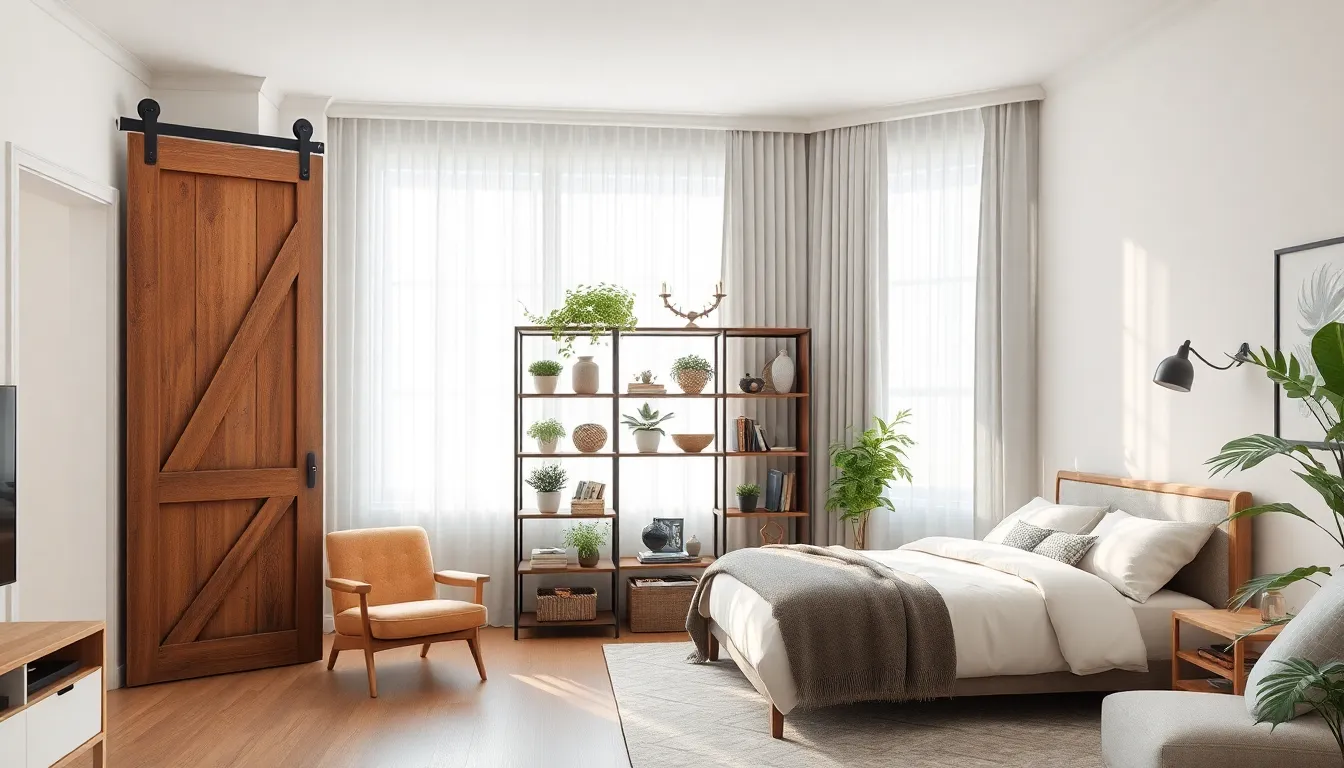
After maximizing our vertical space with Murphy beds and floating answers, we need to address the challenge of defining distinct zones within our combined living room bedroom. Strategic room dividers and screens can transform an open layout into purposeful areas without compromising the flow of natural light.
Install Sliding Barn Doors for Rustic Appeal
Sliding barn doors provide the perfect solution for homeowners seeking both functionality and rustic charm in their living room bedroom combinations. These doors operate on ceiling mounted tracks that require minimal floor space while offering complete privacy when needed. Wood materials like reclaimed oak or pine create authentic farmhouse aesthetics, while metal options deliver industrial modern vibes that complement contemporary decor styles.
Installation involves mounting sturdy hardware systems to ceiling joists or wall studs to support the door’s weight during operation. Most sliding barn doors measure between 36 to 96 inches wide, allowing us to customize coverage based on our exact room dimensions. The beauty of this approach lies in its dual purpose nature – we can slide the doors open during daytime hours to maintain an airy living space, then close them at night for intimate bedroom privacy.
Use Bookshelf Room Dividers for Added Storage
Bookshelf dividers solve two common small space problems simultaneously by creating visual separation while maximizing storage capacity. These freestanding units typically range from 5 to 8 feet in height, providing adequate privacy screening without blocking overhead lighting completely. Popular configurations include cube organizers, ladder style shelving, and traditional bookcase designs that accommodate various decorative items.
Strategic placement becomes crucial when working with bookshelf room dividers in living room bedroom spaces. We recommend positioning them perpendicular to walls to create natural traffic flow patterns while maintaining accessibility from both sides. Fill alternating compartments with books, plants, storage baskets, and decorative objects to maintain visual interest while preventing the divider from appearing too dense or overwhelming.
Hang Curtain Panels From Ceiling Tracks
Curtain panel systems offer the most flexible and budget friendly approach to creating separation in our living room bedroom combinations. Ceiling mounted tracks allow us to position panels exactly where we need them while maintaining the ability to adjust coverage throughout the day. Fabric choices range from sheer materials that filter light gently to blackout options that provide complete privacy and darkness for quality sleep.
Professional installation involves securing tracks directly to ceiling joists using appropriate hardware rated for the curtain’s weight and frequency of use. Standard panel widths measure 50 to 108 inches, and we can combine multiple panels to achieve desired coverage across wider openings. The versatility of this method allows us to experiment with different colors and textures seasonally, keeping our space feeling fresh and updated without major renovations.
Design Multi-Functional Furniture Arrangements

Creating a cohesive living room bedroom requires strategic furniture choices that maximize both functionality and style. We’ll explore smart pieces that serve multiple purposes while maintaining the elegant aesthetic you’ve established through thoughtful zoning and storage answers.
Select Ottoman Storage Benches for Seating and Storage
Ottoman storage benches transform your space by combining comfortable seating with hidden storage capabilities. Seating versatility becomes essential in dual purpose rooms where every piece must work harder. These benches provide extra seating for guests while concealing linens, blankets, or seasonal items inside their compartments.
Placement options include positioning them at the foot of your daybed or using them as coffee table alternatives in your living area. Storage capacity varies by design, with many models offering removable tops that reveal spacious interior compartments. Style choices range from sleek modern designs to upholstered pieces that complement your existing decor.
Choose Nesting Tables That Double as Bedside Tables
Nesting tables offer incredible space saving potential by tucking smaller tables underneath larger ones when not in use. Compact design makes them perfect for rooms where floor space is at a premium. Pull them apart to create individual bedside tables, or use them together as a coffee table arrangement in your living zone.
Surface area expands or contracts based on your immediate needs, whether you’re hosting friends or settling in for the night. Versatility shines through their ability to serve as laptop stands, display surfaces, or dining spots for casual meals. Choose sets with varying heights to create visual interest while maintaining functionality.
Invest in a Daybed That Functions as Both Sofa and Bed
Daybeds serve as the cornerstone of any successful living room bedroom combination. Dual functionality eliminates the need for separate seating and sleeping furniture, freeing up valuable square footage. Position your daybed against a wall to create a cozy reading nook during the day, then add pillows and blankets for comfortable sleeping at night.
Comfort levels vary significantly between models, so we recommend testing different firmness options to find your ideal balance. Style integration becomes effortless when you choose daybeds with upholstered frames or built in storage drawers. Consider models with trundle options for accommodating overnight guests without compromising your daily living space.
Establish Distinct Zones With Strategic Lighting
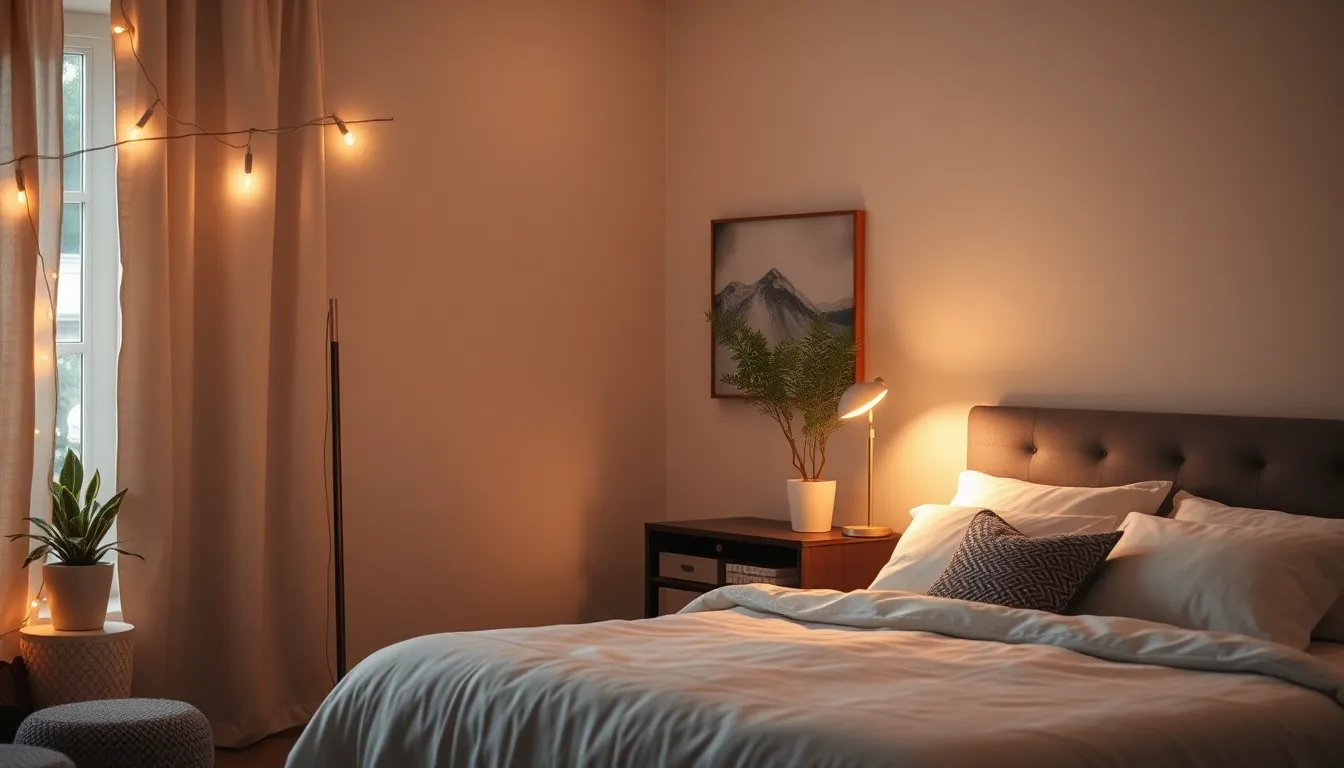
Creating distinct zones through strategic lighting transforms combined living room bedroom spaces into well-defined functional areas. We’ll explore how proper lighting design can establish clear boundaries while maintaining the cohesive flow of your multifunctional space.
Install Dimmer Switches for Adjustable Ambiance
Installing dimmer switches provides the ultimate control over your room’s atmosphere throughout the day. We can easily adjust light levels to differentiate between living and bedroom areas with simple wall controls. These switches allow us to create bright, energizing light for daytime activities in the living zone while dimming the bedroom area for relaxation.
Dimmer technology offers important flexibility in mood setting across different zones. We’re able to gradually transition from bright task lighting during work hours to soft ambient lighting for evening wind-down routines. The adjustable nature means we can customize each area’s brightness based on exact activities like reading, watching TV, or preparing for sleep.
Modern dimmer switches work with various bulb types including LED and CFL options. We can install them on existing light fixtures without major electrical overhauls. The energy savings from dimmed lighting also reduces utility costs while extending bulb life.
Use Floor Lamps to Define the Bedroom Area
Using floor lamps creates immediate visual separation between sleeping and living spaces. We position these lamps strategically beside the bed to establish a cozy reading nook while clearly marking the bedroom zone. Floor lamps provide focused lighting that doesn’t spill into other areas of the room.
Tall floor lamps serve as vertical elements that naturally divide spaces without physical barriers. We can choose styles that complement our decor while providing task lighting for bedside activities. The height of floor lamps draws the eye upward, creating the illusion of separate rooms within the same space.
Placement flexibility makes floor lamps ideal for rental properties where permanent changes aren’t possible. We’re able to reposition them as needed to accommodate furniture rearrangements or seasonal updates. The portability factor allows us to experiment with different zone configurations until we find the perfect layout.
Add String Lights for Cozy Evening Atmosphere
Adding string lights creates warm, inviting ambiance in the living area that visually distinguishes it from the bedroom zone. We can drape them along walls, around windows, or above seating areas to establish a cozy evening retreat. String lights provide soft illumination that doesn’t interfere with sleep preparation in the bedroom area.
The gentle glow from string lights helps define the living space without harsh boundaries. We’re able to create romantic dinner settings or relaxing conversation areas using these versatile light sources. Battery operated options eliminate the need for outlet proximity, giving us complete placement freedom.
String lights offer seasonal versatility that keeps our space feeling fresh throughout the year. We can swap between warm white lights for winter coziness or colored options for festive occasions. The affordable nature of string lights allows us to experiment with different patterns and densities to achieve our desired atmosphere.
Optimize Storage Solutions for Dual-Purpose Spaces
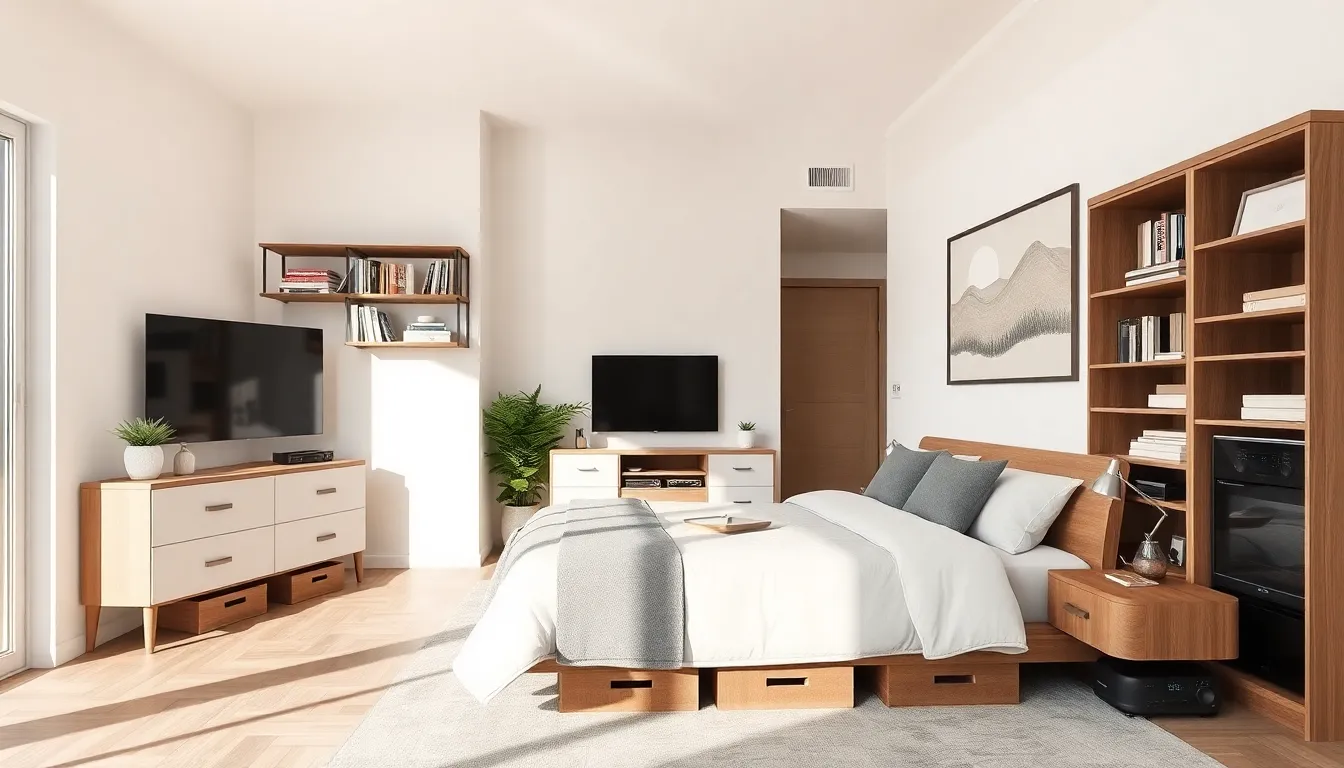
Smart storage transforms cluttered dual-purpose rooms into organized, functional spaces. We’ll explore three essential strategies that maximize every square inch while maintaining the room’s aesthetic appeal.
Use Under-Bed Storage Containers
Under-bed storage containers provide the perfect solution for hiding linens, out-of-season clothes, and less frequently used items. We recommend choosing containers with wheels for easy access and clear sides to quickly identify contents. These practical organizers free up valuable floor space while keeping essentials within reach.
Rolling storage bins work exceptionally well for bedding sets, winter coats, and seasonal decorations. Vacuum-sealed bags inside these containers maximize capacity by compressing bulky items like comforters and pillows. We suggest measuring your bed’s clearance height before purchasing to ensure a proper fit.
Install Floating Shelves Above the Headboard
Floating shelves above the headboard create vertical storage without sacrificing floor space. We position these shelves at varying heights to display books, plants, and decorative pieces while keeping personal items easily accessible. This approach maintains the room’s open feel while adding functional storage.
Staggered shelf arrangements offer visual interest and accommodate items of different sizes. We recommend installing shelves 12-18 inches above the headboard to prevent head bumps while sitting up in bed. LED strip lighting underneath these shelves creates ambient lighting and highlights displayed items.
Choose Armoires That Hide Entertainment Centers
Armoires with built-in entertainment storage conceal TVs, gaming consoles, and media equipment when not in use. We select pieces with adjustable shelving and cable management systems to accommodate various electronics. These versatile furniture pieces reduce visual clutter and maintain the room’s cohesive design.
Modern armoires feature soft-close doors and ventilation systems to protect electronics from overheating. We position these units strategically to serve both living room and bedroom functions without overwhelming the space. Built-in modular furniture and tall storage units further maximize vertical space while keeping floors clear and creating an open, airy atmosphere.
Choose Color Schemes That Unify Both Areas

Creating visual harmony between your living and bedroom areas requires thoughtful color coordination that makes the entire space feel intentional and cohesive.
Use Neutral Tones for Seamless Flow
Neutral color palettes create the foundation for a unified living room bedroom space. We recommend incorporating beige, cream, and light gray throughout both areas to establish visual continuity that makes the room feel larger and more cohesive. These timeless hues work exceptionally well in studio apartments where distinct zones need to flow together seamlessly.
Warm neutrals like soft taupe and ivory help create an inviting atmosphere that transitions beautifully from day to night. Cool neutrals such as pale gray and off white provide a crisp, modern backdrop that allows your furniture and decor to take center stage. We suggest painting walls in a single neutral shade to eliminate visual breaks that might make the space feel choppy or disconnected.
Add Accent Colors Through Textiles and Accessories
Textiles and accessories offer the perfect opportunity to introduce personality without overwhelming your unified color scheme. We incorporate accent colors through throw pillows, blankets, and area rugs that can easily be swapped out seasonally or when you want a fresh look. Rich jewel tones like emerald green or sapphire blue work beautifully against neutral backgrounds.
Curtains and window treatments provide another excellent way to add visual interest while maintaining cohesion between zones. We recommend choosing fabrics that complement your neutral base while adding just enough color to create focal points. Artwork and decorative objects allow you to experiment with bolder hues in smaller doses throughout both the living and sleeping areas.
Paint an Accent Wall to Define the Sleeping Zone
An accent wall in the sleeping area creates visual definition while maintaining the overall flow of your combined space. We suggest painting the wall behind your bed in a deeper shade of your neutral palette or introducing a complementary color that still harmonizes with the rest of the room. This technique helps establish the bedroom zone without requiring physical dividers that might make the space feel cramped.
Darker accent walls create intimacy in the sleeping area while lighter walls in the living zone maintain an open, airy feeling. We recommend testing paint colors in different lighting conditions to ensure they work well both during the day and evening hours. Textured paint finishes or subtle wallpaper patterns can add sophisticated depth to your accent wall while reinforcing the boundary between functional areas.
Select Space-Saving Bedroom Furniture Options
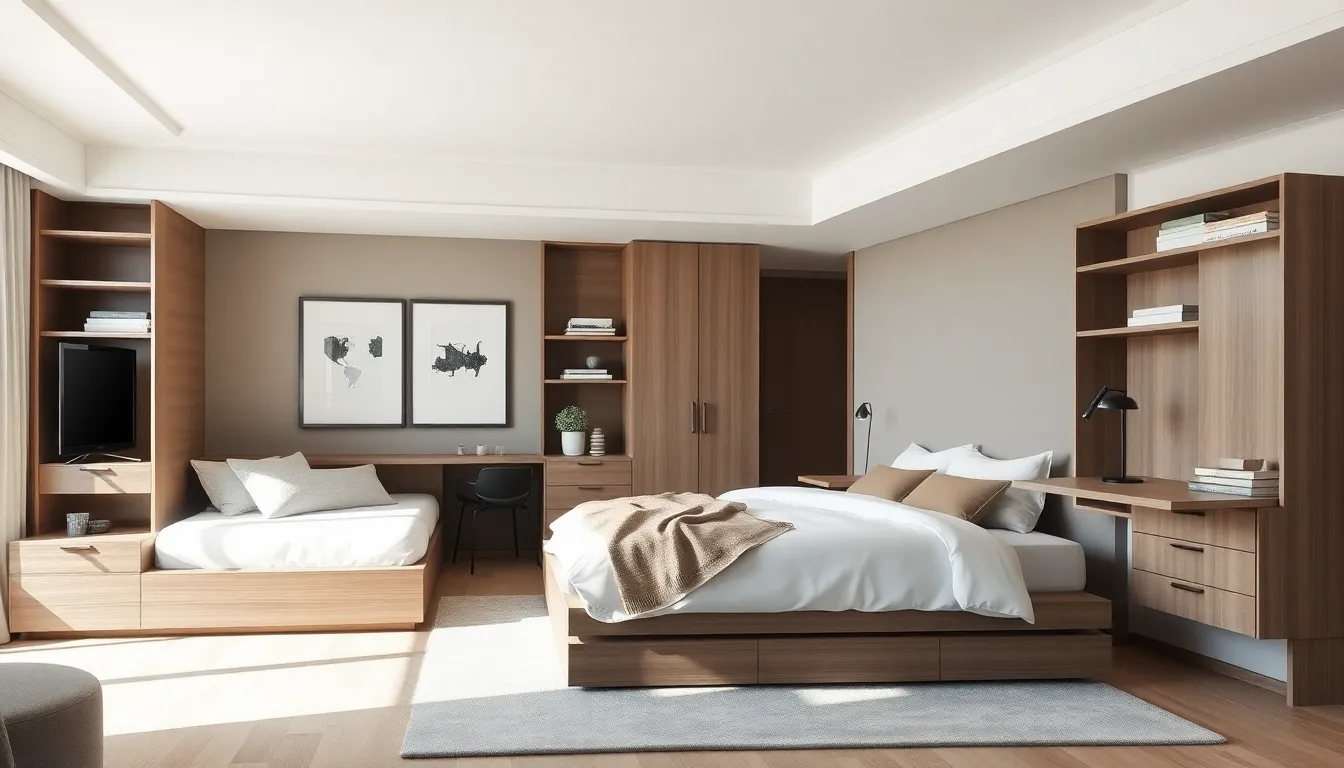
We need furniture that works harder in our combined living room bedroom spaces. Smart bedroom furniture choices can transform cramped quarters into organized, functional areas that serve multiple purposes throughout the day.
Choose Platform Beds With Built-In Storage
Platform beds with storage drawers provide a stable surface for sleeping and lounging while maximizing our floor space. These beds eliminate the need for additional freestanding furniture by incorporating compartments that hold bedding, clothing, and personal items directly beneath the mattress. We can select platform beds with built-in drawers or lift-up storage compartments to keep our room uncluttered and organized.
Built-in storage beds work especially well in compact environments where every square inch matters. Storage compartments keep linens, seasonal clothing, and personal belongings easily accessible yet hidden from view. Platform designs create clean lines that complement both bedroom and living room aesthetics, making the transition between spaces seamless.
Opt for Corner Desks That Don’t Block Traffic Flow
Corner desks in slim designs fit snugly into unused corners without blocking our natural movement patterns through the space. These compact workstations avoid interrupting traffic flow while providing dedicated workspace for laptops, books, and office supplies. We can choose corner desks that tuck into tight spaces and leave the center of our room open for living activities.
Strategic corner placement maximizes our available square footage while creating a defined work zone. Slim profile desks maintain the openness we need in multi-purpose rooms, allowing us to move freely between living and sleeping areas. Corner desks with minimal footprints ensure we don’t sacrifice comfort for functionality in our combined spaces.
Install Wall-Mounted Fold-Down Desks
Wall-mounted fold-down desks create workspaces that disappear when we’re not using them, freeing up valuable floor space for relaxation or guest seating. These space-saving answers mount directly to our walls and fold flat against the surface when closed, maintaining the clean lines essential in living room bedroom combinations. We can install fold-down desks at the perfect height for comfortable work sessions that tuck away completely afterward.
Fold-down desks offer flexibility that freestanding furniture simply can’t match in tight quarters. Wall mounting keeps our floor clear for daily activities while providing a dedicated workspace when needed. These desks transform unused wall space into functional work areas without permanent commitment to floor space, making them ideal for our multi-purpose living arrangements.
Incorporate Privacy Solutions for Better Rest
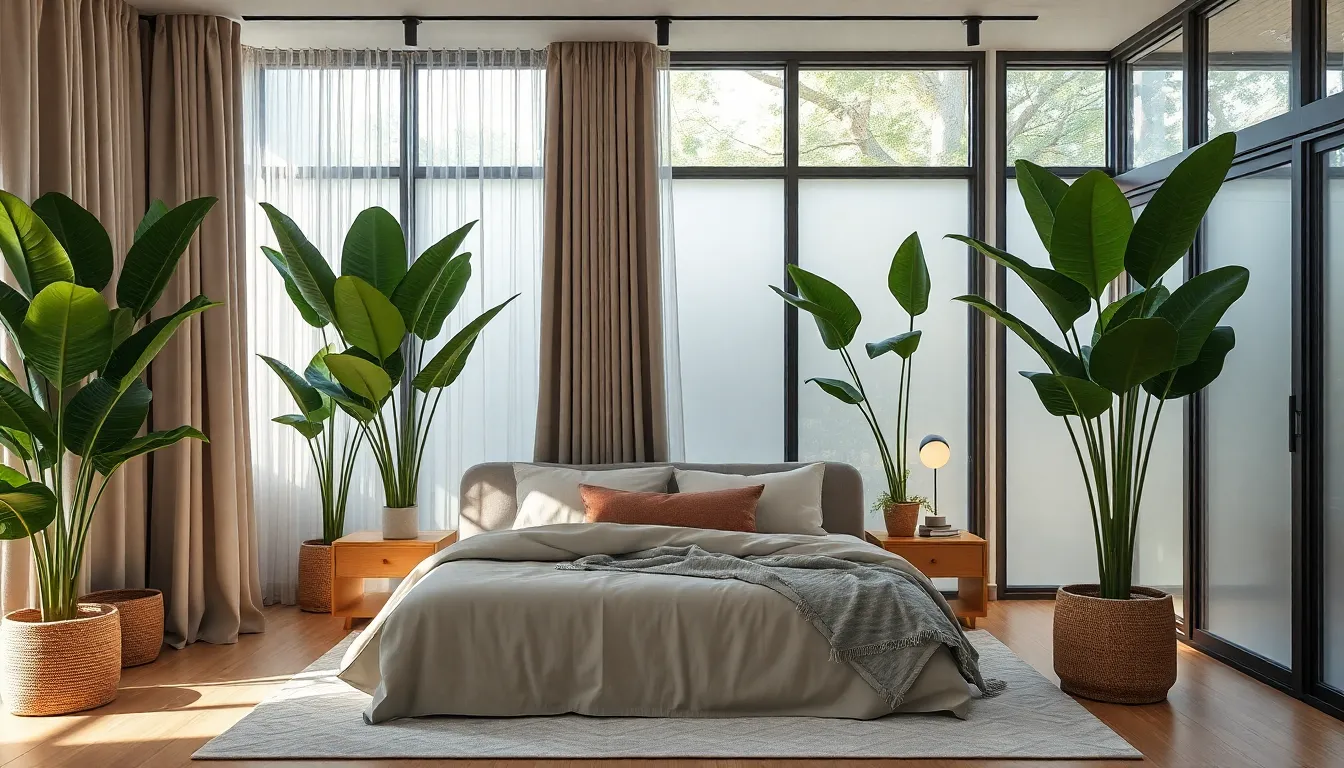
Privacy becomes essential when your living room doubles as your bedroom sanctuary. We’ll explore effective answers that create intimate sleeping spaces while maintaining the functionality of your dual-purpose room.
Hang Heavy Curtains Around the Bed Area
Heavy curtains transform any bed area into a private retreat within your living room bedroom. Installing curtain rods from ceiling to floor allows you to completely enclose your sleeping space, blocking both light and visual distractions. We recommend choosing blackout curtains or heavy drapes in neutral tones that complement your existing color scheme while providing maximum privacy coverage.
Adjustable curtain systems give you complete control over your personal space throughout the day. Drawing curtains closed signals bedtime mode, while opening them integrates the sleeping area back into your living space. This flexibility proves invaluable for studio apartments where every square foot serves multiple purposes.
Use Tall Plants as Natural Room Dividers
Tall plants create organic boundaries between your living and sleeping areas without sacrificing natural light flow. Fiddle leaf figs, rubber trees, and bamboo palms work exceptionally well as living dividers, reaching heights of 6-8 feet while adding fresh air and visual appeal to your space. We suggest grouping plants of varying heights to create a more substantial barrier that feels intentional rather than random.
Strategic plant placement maintains the open feel of your room while establishing clear zones for different activities. Position larger plants at the foot of your bed or along one side to create a natural screen that defines your sleeping area. These green dividers also improve air quality and bring calming natural elements into your multifunctional space.
Install Frosted Glass Panels for Modern Privacy
Frosted glass panels deliver sleek, contemporary privacy answers that filter light while maintaining spatial openness. These panels can be mounted on tracks for sliding functionality or installed as permanent fixtures depending on your layout preferences. We recommend tempered frosted glass for safety and durability, especially in high-traffic areas where the panels might experience occasional contact.
Modern glass dividers allow natural light to flow throughout your space while creating distinct visual separation between zones. The translucent quality prevents your room from feeling cramped or divided, making this solution ideal for smaller living room bedrooms where maintaining brightness is crucial. Professional installation ensures proper mounting and smooth operation for sliding panel systems.
Conclusion
Creating a successful living room bedroom combo doesn’t have to mean sacrificing style or comfort. We’ve shown you that with the right furniture choices wall-mounted answers and strategic design elements you can transform even the smallest space into a sophisticated dual-purpose haven.
The key lies in embracing multifunctional pieces that work overtime for your lifestyle. From Murphy beds that disappear during the day to clever storage answers that keep clutter at bay every element should serve multiple purposes while maintaining visual appeal.
Remember that thoughtful lighting strategic color choices and smart privacy answers can make all the difference in how your space feels and functions. With these ideas in your design toolkit you’re ready to create a living room bedroom that seamlessly transitions from day to night while maximizing every square inch of your home.
Frequently Asked Questions
What are the best space-saving furniture options for a living room bedroom combo?
Murphy beds are ideal for small spaces, with horizontal versions working best in wider rooms. Platform beds with built-in storage drawers maximize floor space while keeping belongings organized. Daybeds serve dual purposes as sofas during the day and beds at night. Ottoman storage benches provide seating while concealing linens, and nesting tables can function as bedside tables or coffee tables as needed.
How can I create separate zones in a studio apartment?
Use strategic room dividers like sliding barn doors for privacy while saving floor space. Bookshelf dividers provide visual separation and additional storage. Hanging curtain panels from ceiling tracks offers flexible, budget-friendly separation. Tall plants act as natural room dividers without blocking light flow, while frosted glass panels maintain openness while filtering light.
What lighting strategies work best for multifunctional spaces?
Install dimmer switches to transition from bright task lighting to soft ambient lighting, helping differentiate living and bedroom areas. Floor lamps create visual separation while providing focused lighting. String lights add warmth to living areas and help distinguish them from bedroom zones. Wall-mounted reading lights replace bulky table lamps while providing adjustable lighting.
How do I maximize storage in a small living room bedroom?
Use under-bed storage containers with wheels for easy access to linens and seasonal items. Install floating shelves above the headboard for vertical storage without sacrificing floor space. Armoires can conceal entertainment centers with adjustable shelving and cable management. Wall-mounted solutions and floating nightstands help maintain clean lines while providing necessary storage.
What color schemes work best for combined living and bedroom spaces?
Neutral tones like beige, cream, and light gray create seamless flow and make spaces feel larger. Introduce accent colors through textiles and accessories for personality without overwhelming the design. Paint an accent wall in the sleeping area to define zones while maintaining overall flow. Use darker shades for intimacy or lighter shades for an airy feel.
How can I ensure privacy in a multifunctional space?
Hang heavy blackout curtains around the bed area to create a private retreat with adjustable systems for daytime flexibility. Use tall plants as natural room dividers that provide organic boundaries without sacrificing light. Install frosted glass panels for a modern privacy solution that filters light while maintaining openness, perfect for smaller spaces.







